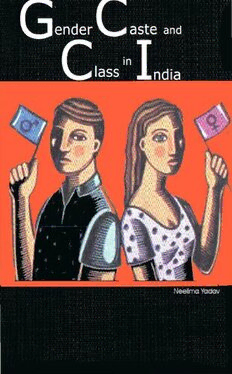
Gender, Caste and Class in India PDF
Preview Gender, Caste and Class in India
GGEENNDDEERR,, CCAASSTTEE AANNDD CCLLAASSSS IINN IINNDDIIAA GENDER, CASTE AND CLASS IN INDIA By Neelima Yadav PRAGUN PUBLICATIONS (A O.K. PUBLISHERS DISTRIBUTORS ENTERPRISE) 4224/1, Ansari Road, Darya Ganj, New Delhi-ll0002 Ph. : 011-41562573-77 Fax: 011-41562578 E-mail: [email protected] urI: www.dkpd.com Published by: Pragun Publications (A D.K. Publishers Distributors Enterprise) 4224/1, Ansari Road, Darya Ganj, New Delhi-110002 Ph. : 011-41562573-77 Fax: 011-41562578 E-mail: [email protected] uri: www.dkpd.com Distributed by: O.K. Publishers Distributors Pvt. Ltd. 4834/24, Ansari Road, Darya Ganj, New Delhi - 110002 Ph.: 011-41562573 (5-lines) Fax: 011-41562578 E-mail: [email protected] uri: www.dkpd.com © Pragun Publications, 2006 All rights reserved. No part of this publication may be reproduced, stored in a retrieval system, or transmitted, in any form or by any means, without the prior permission in writing of Pragun Publications, or as expressly permitted by law, or under terms agreed with the appropriate reprographics rights organization. Enquiries conceming . reproduction outside the scope of the above should be sent to the Publishers, at the address above. You must not circulate this book in any other binding or cover and you must impose this same condition on any acquiror ISBN: 81-89645-08-0 Published in India and Printed at : liP Printers, New Delhi -110015 Mobile: 9810271526 Preface An analysis of the status of women depends on an understanding of gender relations in a specific context. Examining gender relations as power relations makes clear that these are sustained by the institutions within which gender relations occur. For women, absence of power results in the lack of access to and control over resources, a coercive gender division of labour, devaluation of their work, and a lack of control over their own labour, mobility as well as sexuality and fertility. Gender equality thus demands substantive transformation, a set of policies and conditions created by the state that facilitate the reallocation of resources, thereby increasing women's control over resources that confer power at individual, household, and societal levels. Transformation for gender equality envisages the empowerment of women, requiring conditions that enable women to exercise their autonomy; it also envisages a process of self-empowerment, in which women begin to re-examine their lives critically and collectively. While the former involves the facilitation of women's access to and control over resources, the latter emphasizes women's agency in seeking greater access and control. Measures of gender equality therefore require an assessment of the degree to which resources have been vi Gender, Caste and Class in India redistributed; whether state policy has facilitated women's autonomy; and the extent to which unequal gender relations have been transformed. Contemporary India's political landscape is characterized by a great deal of social upheaval. This is the result of growing democratic consciousness which is increasingly conflicting with the forces of domination, authoritarianism and hegemony. The control of women's physical mobility, a crucial aspect of status, is also influenced by caste, class, religious, and community strictures. While women's physical mobility may increase with their entry into the labour force, it also makes them vulnerable to assault, molestation, and rape. This book looks into the dynamic interconnection of class, caste and gender in the Indian political systems. The complex issues of caste, gender and class have been studied through a collection of chapters that look into the people's struggle for social equality. Social oppression has been analY$ed in the context of protests against such exploitation. Anti-caste movements and women's movements have been studied in much detail. The book also is divided into eleven chapters. This important book will contribute immensely in the understanding of the contemporary Indian gender analysis. Gender, caste, and class in India demonstrates that caste and class processes cannot be fully addressed without considering their interrelationship with gender. Editor Contents Preface v 1. Gender Analysis' 1 2. Caste in Indian Society 41 3. Caste and Social Articulation 52 4. Caste, Gender and Schooling 94 5. Gender and the Legal Liberalism 118 6. Caste Based Reservation 128 7. Dalit Women in Indian Society 144 8. Wages, Employment and Agrarian Economy 151 9. Women's Autonomy 181 to. Gender Discrimination and Poverty 200 11. Gender Disparities among Poor 238 Bibliography 263 Index 265 1 Gender Analysis GENDER AND CASTE The upper classes, insulated from the effects of caste-based discrimination, tend to believe that the caste system is a part of India's antiquated past, an age-old system that no longer has relevance. Invisibility of caste is a fallacy. The caste system is very much a part of modem Indian society and politics. Its interactions with gender, religion and other variables make it a defining factor in many social and economic processes and its effect on these processes must be c.:onsidered in any accurate analysis of the Indian polity. Dalit communities, schedule castes (15% of the population) and schedule tribes (7%) are the largest and most well known lower caste groups in India today. Historically discriminated against, studies show that poverty rates among these groups are still markedly higher than those among other groups. However, the position of women within these gro.ups is worth noting. DaHt communities have only marginally lower Gross Enrolment Ratios for girls than the national population, and there is only a negligible gap between GERs for boys and girls. Women within these groups also have higher labour force participation rates, and are thus less likely to be involved exclusively in domestic duties, thou&h their
